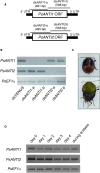Characterization of two adenine nucleotide translocase paralogues in the stink bug, Plautia stali
- PMID: 30363102
- PMCID: PMC6140647
- DOI: 10.1584/jpestics.D15-080
Characterization of two adenine nucleotide translocase paralogues in the stink bug, Plautia stali
Abstract
Adenine nucleotide translocase (ANT) is a nuclear-coded mitochondrial protein that exchanges ATP for ADP across the mitochondrial inner membrane. Most organisms possess several ANT paralogues, and functional differences among these paralogues remain largely unknown. In the present study, we identified ANT paralogue genes in hemipteran species: the stink bug, bean bug, pea aphid, and Japanese mealybug. The ANT paralogues of the stink bug, Plautia stali, are encoded by two genes, PsANTI1 and PsANTI2. PsANTI1 was constantly expressed at all developmental stages and in all tissues analyzed. In contrast, the expression levels of PsANTI2 were undetectable in first instar nymphs and adult antennae. Gene silencing of each paralogue in P. stali revealed that PsANTI1 plays an important role in homeostasis, whereas the depletion of PsANTI2 failed to result in lethality. Thus, we concluded that PsANTI1 is a good target gene for developing novel pesticides.
Keywords: Hemiptera; RNAi; adenine nucleotide translocase; gene expression; stink bug.
Figures
Similar articles
-
Two adenine nucleotide translocase paralogues involved in cell proliferation and spermatogenesis in the silkworm Bombyx mori.PLoS One. 2015 Mar 5;10(3):e0119429. doi: 10.1371/journal.pone.0119429. eCollection 2015. PLoS One. 2015. PMID: 25742135 Free PMC article.
-
Biological activities of juvenile hormone III skipped bisepoxide in last instar nymphs and adults of a stink bug, Plautia stali.J Insect Physiol. 2011 Jan;57(1):147-52. doi: 10.1016/j.jinsphys.2010.10.003. Epub 2010 Oct 27. J Insect Physiol. 2011. PMID: 20969871
-
Construction of an expressible BAC library of the unculturable insect microorganism, stink bug Plautia stali symbiont, for the search of biologically active and useful symbiont products.Biol Pharm Bull. 2014;37(4):528-33. doi: 10.1248/bpb.b13-00688. Biol Pharm Bull. 2014. PMID: 24694601
-
The chemical volatiles (semiochemicals) produced by neotropical stink bugs (Hemiptera: Pentatomidae).Neotrop Entomol. 2008 Sep-Oct;37(5):489-505. doi: 10.1590/s1519-566x2008000500001. Neotrop Entomol. 2008. PMID: 19061033 Review.
-
Adenine nucleotide translocase family: four isoforms for apoptosis modulation in cancer.Oncogene. 2011 Feb 24;30(8):883-95. doi: 10.1038/onc.2010.501. Epub 2010 Nov 15. Oncogene. 2011. PMID: 21076465 Review.
Cited by
-
Ovicidal activity of juvenile hormone mimics in the bean bug, Riptortus pedestris.J Pestic Sci. 2021 Feb 20;46(1):60-67. doi: 10.1584/jpestics.D20-075. J Pestic Sci. 2021. PMID: 33746547 Free PMC article.
-
Effectiveness of orally-delivered double-stranded RNA on gene silencing in the stinkbug Plautia stali.PLoS One. 2021 Jan 14;16(1):e0245081. doi: 10.1371/journal.pone.0245081. eCollection 2021. PLoS One. 2021. PMID: 33444324 Free PMC article.
-
Sex-specific expression profiles of ecdysteroid biosynthesis and ecdysone response genes in extreme sexual dimorphism of the mealybug Planococcus kraunhiae (Kuwana).PLoS One. 2020 Apr 13;15(4):e0231451. doi: 10.1371/journal.pone.0231451. eCollection 2020. PLoS One. 2020. PMID: 32282855 Free PMC article.
References
-
- T. Suga, Y. Asami, S. Hashimoto, K. Nonaka, M. Iwatsuki, T. Nakashima, R. Sugahara, T. Shiotsuki, T. Yamamoto, Y. Shinohara, N. Ichimaru, M. Murai, H. Miyoshi, S. Ōmura and K. Shiomi: J. Antibiot. 68, 649–652 (2015). - PubMed
-
- T. Suga, Y. Asami, S. Hashimoto, K. Nonaka, M. Iwatsuki, T. Nakashima, Y. Watanabe, R. Sugahara, T. Shiotsuki, T. Yamamoto, Y. Shinohara, N. Ichimaru, M. Murai, H. Miyoshi, S. Ōmura and K. Shiomi: J. Gen. Appl. Microbiol. 61, 82–87 (2015). - PubMed
-
- M. Klingenberg: Arch. Biochem. Biophys. 270, 1–14 (1989). - PubMed
-
- D. R. Nelson, C. M. Felix and J. M. Swanson: J. Mol. Biol. 277, 285–308 (1998). - PubMed
LinkOut - more resources
Full Text Sources



